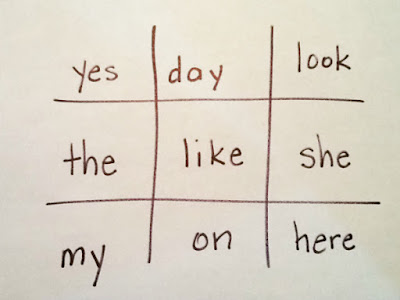How many things do we do out of habit or custom? I've alluded to this when writing about the power of yes. But I was struck by it again the other day when tutoring in reading clinic.
My reading buddy and I were preparing to play the tic-tac-toe word game. (See below if you want to know more about this game.) I reminded him how to play the game and asked if he wanted to be X or O. "Can we be other letters?" he asked.
"No," I said. "Let's just play in the ....." My mind interrupted my words. Why couldn't we play with other letters? Did it really matter? Would he be more engaged if we used other letters? Why not?
I stopped talking and took a breath. "Sure," I said. "We can play with other letters. Which letters did you want to use?"
He chose Y and Z; he was Y and I was Z. He read the first word. As he erased the word to write his letter, he said, "You have to make the letter like the word you read." He had read collar so he drew a Y with a collar around it. We went back and forth, reading words and drawing interesting letters. Do you know what I noticed? Not only was he very engaged in the game, he had to think about the word and how to represent it. (We were building vocabulary knowledge, too!)
I almost insisted we use X and O - just because that is the custom that we use in playing tic-tac-toe. (And why is that? I don't know.) But moving out of that "habit" allowed the game to be more interesting and more instructive.
I'm going to look for other things that I do in a habitual way. What can happen with a little adjustment? I can't wait to find out.
Tic-Tac-Toe Game
We use a dry erase board, markers, and eraser.
Draw a standard tic-tac-toe grid. Print words in each space. Players must read the word to get a space. Read the word, erase the word, draw in the X or O (or whatever you are using!). Three in a row wins!
Use sight words, vocabulary words, letters, numbers, colors, or other concepts in the spaces. You could even have simple addition and subtraction facts in the spaces. Instead of printing on the board, print words or facts on cards and lay the cards in the spaces. Pick up the cards after reading or solving and place the X or O. Make a stack of cards to replenish the grid and play several games.

